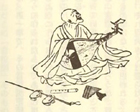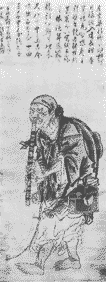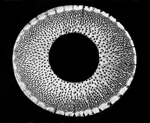
'Komosō' shakuhachi lay-monk
In: 'Sanjūniban shokunin
uta-awase'
Edo period copy
Source: Ueno, 1984

'Boro' nenbutsu lay-monk
In: 'Shichijūichi-ban
shokunin uta-awase'
Edo period copy
Source: Ueno, 1983

'Boro' nenbutsu lay-monk
In: 'Shichijūichi-ban
shokunin sta-awase'
Edo period copy
Source: Gunsho Ruijū, Vol. 28

'Boro' nenbutsu lay-monk
In: 'Shichijūichi-ban
shokunin uta-awase'
Edo period copy
Source: Nakatsuka, 1979

'Boro' nenbutsu lay-monk
In: 'Shichijūichi-ban
shokunin uta-awase'
Edo period copy
Source: Kurihara, 1975

'Komo-sō'

'Komosō' shakuhachi lay-monk
In: 'Sanjūniban shokunin
uta-awase emaki'
Edo period copy
Source: NKBZ, 1976

"Biwa-hōshi" - (blind) lute monk
In: 'Shichijūichi-ban
shokunin uta-awase'
Edo period copy
Source: Ueno, 1984

'Hitoyogiri' (short shakuhachi)
and 12 pitch pipes
(detail of the above)
In: 'Shichijūichi-ban
shokunin uta-awase'
Edo period copy
Source: Ueno, 1984

'Biwa-hōshi' - (blind) lute monk
In: In: 'Shichijūichi-ban
shokunin uta-awase'
Edo period copy
Source: Gunsho Ruijū, Vol. 28

'Hitoyogiri' shakuhachi
In: 'Taigenshō', 1512
Source: Koji Ruien
|
Chronology
JAPAN 3 • 1477-1560
1477-1560 - The ERA of the ORIGINAL KOMO-SŌ
朗庵吹笛画 - RŌAN SUITEKI-GA
無常心 - MUJŌ-SHIN
1477? - PAINTING of RŌAN PLAYING a LONG VERTICAL FLUTE
Is this really a "genuine work of art"?


Picture of Rōan Playing a Flute
Painting attributed to the Zen monk and painter Shōkei,
aka Kei Shoki, "Clerksman Kei", who was active
during the last two decades of the 1400s and died in 1518.
In the collection of the late Kowata Suigetsu 木幡吹月, 1901-1983

Another Picture of Rōan Playing a Flute discovered on the internet, uncommented.
If you study and compare this picture closely with the two smaller ones above it you will soon realize that they are actually quite different!
How can this be? Which of them is the original - which is a copy?
Are they both falsifications?
If this were indeed a genuine painting, more than 500 years old, it would have been created sometime between 1467, when the renowned painter monk Kenkō Shōkei,
賢江祥啓,
was appointed clerksman/calligrapher at the Kenchō Zen Temple in Kamakura, and 1477, when the shakuhachi hermit Rōan supposedly added his short anecdote, his
Chinese style 4-line 7-syllable poem, and the place and date, at the top of this quite mysterious hanging scroll.
It has so far been impossible to locate a proper high resolution picture of the painting which includes the written text.
Acc. to an internet web page (see link below) the hanging scroll is reproduced in the Nihon-ga taisei,
日本画大成, "A Compilation of Japanese Painting", 1931, Vol. 3, Plate 66.
Fortunately, the shakuhachi scholar Ueno Katami appears to have had access to the original painting (or a good reproduction)
and he has presented the complete text in his book
Shakuhachi no rekishi, "History of the Shakuhachi", published in 2002 (revised and enlarged edition, first publ. in 1983), on page 153.
Whether this painting attributed to Shōkei is actually "a fabrication", or not, let us appreciate the story and its sincere message for all it is worth, anyway:
余、東奥行脚の砌、相州巨福路,
建長禅寺宝珠庵に入り沓憇す。
庵主祥啓書記、吾が躰、甚だ異なるを相て、
以って 紙上に写し、而して予に給す。
依って年来演じる所を執って云う。
"While I [Rōan] was performing a pilgrimage along the Kobuku Road in Sōshū
[Sagami, mod. Kanagawa Pref.] I entered the Hōju Hermitage at the Kenchō
Zen Temple in [Kamakura] and rested my feet.
The clerksman there, Shōkei the Hermit, noticed my very strange appearance,
then rendered [my portrait] on paper and, eventually, bestowed it on me.
For this reason, I said that I would form an attachment, committing myself
to [come and] play [the shakuhachi] at that place for years to come."
竜頭切断兮以来
尺八寸中通古今
吹出無常心一曲
三千里外絶知音
"When Dualism is cut off,
the shakuhachi dissolves the distinction between Past and Present.
That one unique Sound of Everlasting Impermanence
brings even the Purest of Wisdom [Skt.: Jnana] to an end,
without limit."
時に文明丁酉 秋 宇治の旧蘆に於いて 朗庵叟書
"The 9th year of Bunmei [1477] - Autumn -
Written among the old reeds of Uji by Rōan the Elder."
Trsl. by Torsten Olafsson, 2010 & 2013.
Source: Ueno, 2002, pp. 152-153.
A rather poor version of the painting can be found here:
www.um.u-tokyo.ac.jp/publish_db/1994collection1/tenji_kaiga_48.html
www1.cncm.ne.jp/~seifu/rouanzu.htm &
The poem is quite similar to poems preserved in
various versions of the kyōgen play 'Rakuami'.
楽阿弥 - RAKUAMI
両頭 - RYŌTŌ - "Dualism"
Late 15th century?: The Kyōgen Play 'RAKUAMI'
- possibly the oldest piece in the kyōgen repertory.
両頭を切断してより此かた
尺八寸の内、古今に通ず
吹き起こす無常心の一曲
三千里外に知音は絶す
"When both ends are cut, the Middle Way is clear;
One Breath through the flute joins past and present.
In three thousand leagues there will be none
Who understands an enlightened tone."
Poem recited by the ghost of Rakuami
in the dance-kyōgen play 'Rakuami',
possibly late 15th or early 16th century.
Translated by Carolyn M. Haynes, 1988, p. 271.
少林無孔笛 - SHŌRIN MUKUTEKI
Late 15th century: TŌYŌ EICHŌ & 'SHŌRIN MUKUTEKI'

Portrait of Tōyō Eichō, 1428-1504
Anonymous. Owned by Daisen-ji, Gifu Prefecture
無孔笛最難吹
(むくてきもっともふきがたし)
Mukuteki mottomo fukigatashi.
"A Flute with No Holes is the most difficult to blow."
Trsl. by Torsten Olafsson.
Source: Hori, 2003, p. 72 & p. 252.
The renowned Zen monk of the Myōshin-ji line of Rinzai Zen Tōyō Eichō,
東陽英朝, 1428-1504,
was among the first to collect socalled "capping phrases" for kōan study.
The above cited phrase is but one among numerous such capping phrases presented in the Zenrin kushū collection by Ijūshi (n.d.), published in 1688.
It remains so far undetermined whether that particular capping phrase may actually have been contained in Tōyō Eichō's capping phrase collection Kuzōshi
dating from the late 15th century.
In any case, Tōyō Eichō was the author of a most impressive literary work entitled Shōrin mukuteki, "The Shōrin Flute Without Holes",
which was, eventually, published in 1709 (Hōei 6) in 6 volumes, edited by Ueda Shōshin.
A copy of that work is preserved at the Komazawa University Library.
The term mukuteki does in fact appear in quite a number of old Chinese & Japanese Buddhist texts - link to the
SAT Daizōkyō Text Database
By the way, in Volume 1 of the Shōrin mukuteki, one finds a very interesting passage that mentions both Ikkyū Sōjun playing the shakuhachi
- and: The grandeur of Priest Fuke whose anti-Dualism Myō-An poem that Ikkyū is known to have recited at the inauguration ceremony at Daitoku-ji in 1474.
Acc. to Tōyō Eichō, he actually witnessed Ikkyū Sōjun playing the (hitoyogiri?) shakuhachi in the Zen temple Daitoku-ji in Kyōto
on that very day, in late 1474, when Ikkyū entered the Abbot's Quarters of the temple to become its rebuilder and restorer.
Tōyō Eichō recorded as follows,
不寒臘後
看一休和尚
入牌祖堂正宗滅却。
- - -
狂雲吹起寶山巓。
"In the not cold Winter,
after the offering ceremony held on the third Day of the Dog after the Winter solstice [12th month, 1474],
I saw Abbot Ikkyū as he entered beneath the sign board of
the Founder's Hall [of Daitoku Temple in Kyōto]
after its destruction [in the Ōnin War, 1467-1477].
- - -
Kyōun [Ikkyū's literary name] blew forth [the tune] Hōsanten, "Summit of the Treasure Mountain"."
Link to the full text in question:
Shōrin mukuteki, Chapter 1.
That particular passage is awaiting a complete, final and translation and commentary.

The Zen temple Ryūkyōzan Shōrin-ji in Kakamigahara, Gifu Prefecture
Tōyō Eichō who founded the temple in 1493 (Meiō 2)
lies buried here. Meiji Period drawing
By the way, the term mukuteki also appears in a literary work entitled Shakuhachi mei narabi ni jo, date 1505,
"Shakuhachi Makers' Seals and Introduction", by the Rinzai Zen monk Kōrin (died 1536, Tenmon 5, 6th month, 14th day).
The text is reproduced in Nakatsuka, 1979, pp. 204-206.
1481 - IKKYŪ SŌJUN DIES
Tōyō Eichō, 1428-1504, is appointed jū-ji,
住持, or "chief administrator" of the Zen temple Daitoku-ji i Kyōto.
Source: Louis Frédéric, 2005, p. 170.
舞楽 - BUGAKU
1484: Bunmei 16, 5th Lunar Month, 1st Day:
舞人ひさとき御小庭へ召して、
尺八を吹かせた。
藪、綾小路も召され、
異つた節で 「太平楽」
いろいろさまざま
珍らしくめでたし。
"The court dancer Hisatoki was summoned to the Small Imperial Garden, and we had him play the shakuhachi.
Yabu and Ama no Kōji were also summoned, and at different occasions [they performed the dance] Taiheiraku and various other {dances], [that was] unusually joyful!"
Quoted from the 'Oyudono no ue no nikki',
"Journal of the Upper Hot Water Room".
A diary of the events at the Imperial court, recorded by
the ladies-in-waiting, covering the period 1477-1816.
Source: Nishiyama, 1976, pp. 158-159.
Trsl. by Torsten Olafsson.
1486:
薦僧 - KOMOSŌ
大内氏掟書 - ŌUCHI UJI OKITE-GAKI
薦僧、放下、猿引事、可払当所并近里。
"Regarding the komosō, jugglers, and monkey keepers.
These are all to be expelled from this place as well as from the neighbouring villages."
Quoted from the 'Ōuchi Uji okitegaki', "Recorded Commandments
of the Ōuchi Clan", entry dated 1486. Trsl. by Torsten Olafsson.
Source: NKDJ, Vol. 8, 1973-75.
1494:
三十二番職人歌合絵巻
- SANJŪNIBAN SHOKUNIN UTA-AWASE EMAKI
"Picture Scroll Depicting a Poetry Contest on Thirty-two Professions"
"(uta:) Inmidst of the spring flowers - who should be disturbed by the blowing? It is not the wind but the shakuhachi of the komo.
(kotobagaki:) The samādhi of the komo-sō consists of putting a paper-cape around his shoulder,
hanging a rice bowl at his hip going in front of the doors of the rich and the poor and playing the shakuhachi
- they are of no other use."
Quoted from the 'Sanjūni-ban shokunin uta-awase emaki,
Muromachi Period (1333-1573) picture scroll,
c. 1494. Trsl. by Max Deeg, 2007.
"Amidst spring flowers who should care that the wind blows?
It is not the wind but the shakuhachi of the komo."
"The komo-sō are absorbed in visiting the houses of both rich and poor,
begging and playing shakuhachi - that is all they can do."
Quoted from the 'Sanjūniban shokunin uta-awase emaki',
Muromachi Period (1333-1573) picture scroll,
1494. Trsl. in Blasdel/Kamisangō, 1988.

Komosō in 'Sanjūni-ban shokunin uta-awase emaki'
Date of original: 1494. Kōsetsu-bon version.
Suntory Museum of Art, Tokyo.
Source: Wikipedia, Japan

薦僧 - KOMOSŌ
虚妄僧 - KYOMŌSŌ
六番
右
虚妄僧
花ざかり
ふくとも誰か
いとふべき
風にはあらぬ
こもの尺八。
薦僧の三昧紙きぬ肩にかけ
面桶腰につけ、
貴賤の門戸によりて
尺八ふくほかに
は別の業なき者にや。
No. 6. Right side. Kyomōsō [winning poem]:
'Even if he plays
when the cherries are in bloom,
everybody wants to evade him.
Unwelcome as the wind -
the Komo's shakuhachi.'
The Komosō is clad in paper meditation garments and a food bucket is tied to
his loin. I doubt him to be a person who, besides approaching the gates of high
and low, blowing the shakuhachi, has any other profession."
Quoted from the 'Sanjūni-ban shokunin uta-awase emaki', 1494.
Trsl. by Torsten Olafsson, 1987.
Source: Gunsho Ruijū, Vol. 28, 1933.
No. 22. Right side. Kyomōsō [losing poem]:
二十二番
右
虚妄僧
さし入も、
みそや酒やの、
糟法師、
聲をかへても、
こうは茶はかり。
'That humble monk,
presenting his rice bowl
at miso shop and sake shop;
though modulating his voice,
the only alms he gets is - tea.'"
Quoted from the 'Sanjūni-ban shokunin uta-awase emaki', 1494.
Trsl. by Torsten Olafsson, 2011.
Source: Yamaguchi Masayoshi, 2005, p. 119.

Komosō in 'Sanjūni-ban shokunin uta-awase emaki'
Tōhoku University Library, Kano Collection
16th CENTURY:
琵琶法師 - BIWA-HŌSHI
1501:
七十一番職人歌合絵巻
SHICHI-JŪ-ICHIBAN SHOKUNIN UTA-AWASE EMAKI

Biwa-hōshi with a short single-noded shakuhachi and a panflute by his side
in 'Shichijūichi-ban shokunin utaawase emaki'
Date of original: 1501. Tōkyō National Museum
無孔笛
1505 - THE RINZAI ZEN MONK KŌRIN's SHAKUHACHI ESSAY
- - -
抑若■少林氏則有別調、
是謂無孔笛、
非宮非商、非落梅過雲之曲。
上以於梵世、
下以聞於金剛水際。
既知其音者耳不待聞之也。
- - -
- - -
"Well now, Young Master [1 missing kanji] Shōrin favoured an extraordinary saying,
'That socalled Flute with No Holes is the music not of the nobleman, not of the merchant,
nor of the clouds of falling plum blossoms in the capital.
The upper end accords to the Buddhism World;
the lower end represents Hearing at the Shore of the Diamond Realm [i.e. the "final realization of Mahavairocana Buddha"].
When first you understand that sound, your ears do not serve you hearing (it).'"
- - -
Quoted from the essay 'Shakuhachi mei narabi ni jo',
dated 1505, by the Tōfuku-ji Zen monk Kōrin,
d. 1536. Trsl. by Torsten Olafsson, 2011.
Reprinted in: Nakatsuka Chikuzen, 1979, p. 204-206.
體源抄 / 体源抄
楽人 - GAKUNIN
1512 - TAIGENSHŌ - by Toyohara Sumiaki (1450-1524)

Single-node 'shakuhachi' pictures in the Taigenshō, 1512, Maki 5
The entire 1933 edition of the Taigenshō may be downloaded
from this location:
www.archive.org
- Cheng Yu Tung East Asian Library, University of Toronto
「狂雲子」 or
「狂言」? - KYŌUNSHI or KYŌGEN?
TWO MYSTERIOUS POEMS in the TAIGENSHŌ:


Taigenshō, 1933 edition, Maki 5, pp. 631 & 630 respectively
Link to online version of the Taigenshō Vol. 2 at www.archive.org
- Cheng Yu Tung East Asian Library, University of Toronto
Go to pages 252 & 253 in the PDF, respectively
又、
自兩頭テ切断後
三千里外絶知音
又云、
狂言云シ人作之、
尺八節高円口連
彼尋出處宇治邊
一聲吹落兩樓月
百万軍中聞不眼
"Then,
'When one has cut off Dualism,
that surpasses the deepest of friendship, beyond limit.'
And, it has been said,
a person called Kyōgen composed this.
'The music [or the joint?] of the shakuhachi ennobles the row of circular holes;
He searches out a place in the vicinity of Uji;
The single, lonely voice blows to descent the Twin Tower Moon;
Among a million soldiers you hear it - but do not see.'"
In the 'Taigenshō', maki 5, chapter on Shakuhachi.
Trsl. by Torsten Olafsson, 2010.
Source: Toyohara/Masamune, 1933, vol. 2, pp. 630-631.
歌 - UTA
1518 - POEMS in the KANGIN-SHŪ
" 21 - Dengaku
I take out the shakuhachi from
beneath my sleeve,
to blow it while waiting and
The wind through the pine -
scatters flowers as though a dream
How much longer will I have to play
until my heart is quiet again?"
" 177 - Kouta
My shakuhachi is blameless yet
I toss it at the pillow.
It makes a sound katari as it hits
the wood rim,
Yet even the sound does not make it less
lonely nor less sad
to sleep alone."
" 276 - Kouta
"I blow you while I wait
I blow you later in my disappointment too -
Worthless Shakuhachi!"
Trsl. by Frank Hoff, 1978. In Blasdel/Kamisangō, 1988/2008.
1521-1532 - RAKU-CHŪ RAKU-GAI ZU - Machida-bon edition

Two komosō playing vertical flutes in a Kyōto street
Detail of the folding screen 'Raku-chū raku-gai zu byōbu',
"Pictures from In and Around the Capital",
Machida-bon edition.
Dated to between 1521 and 1532.

Close-up detail of the folding screen 'Raku-chū raku-gai zu byōbu',
"Pictures from In and Around the Capital",
Machida-bon edition.
The National Museum of Japanese History, Sakura City, Chiba Prefecture
宗長手記
1522-1527 - SŌCHŌ SHUKI by SAIOKUKEN SŌCHŌ

Portrait of Saiokuken Sōchō, 1448-1532, with a 'hitoyogiri' by his side
Painting signed 'Kanō Ryūsetsu', a name used by several different members of the Kanō School,
the earliest of whom was Kanō Hidenobu, c. 1647-1712
A treasure of the temple Saioku-ji, late 17th century or later

The chapter about Jōsū in 'Sōchō shuki',
"The Journal of Sōchō" - 1796 edition
Waseda University Library
The poem quoted below is seen in the center of the picture
THE DEATH of JŌSŪ
紹崇として尺八吹僧。
もとは東山霊山の時衆。
五条東洞院常福寺、柴野大仙院四・五年もありて、
此ごろは和泉の堺草庵。
尺八の弟子、だんなにて活計。
伊勢に参宮とて、長阿打ふし山田に逗留。
尋来て十日あまり、長阿は山城薪へのぼりしなり。
昼夜もてなしどもとぞ聞えし。
いかゞ有けん、二見の浦の浪にしづみけるとつたえきゝて,
無常心
おこす一曲
いかにして
ふきしずみけん
あなうみのよや。
"Jōsū, a monk and shakuhachi musician, was originally a member of the Higashiyama Ryōzen Ji sect.
He spent four or five years at Jōfukuji temple at Gojō Higashinotōin and at Daitokuji's Daisen'in,
and until recently he maintained a cottage in Sakai in Izumi Province.
He made his living from shakuhachi students and patrons. I happened to be staying in Yamada when he arrived at Ise Shrine on a pilgrimage;
he called on me and stayed more than ten days, until I had to leave for Takigi at Yamashiro. They tell me he was fêted thereafter in Yamada morning and evening.
Then came the news that he had thrown himself into Futami Bay - what could have happened to make him do such a thing?
I composed this on learning it:
That one melody
"Perceiving the Law of Change" -
how could he play it
then sink into the sea?
How awfully sad, this world!
[Mujōshin
okosu ikkyoku
ika ni shite
fukishizumiken
ana umi no yo ya.]
南部にてつたえ聞し事なるべし。
山田へ申つかはし侍し。
此尺八物にもかへて、跡の事とぶらはんとて、
妹の尼時衆たびたびいえども、つゐにのぼせず。
さらばあすか川かはる瀬をものぼせずとなん。
"I must have been in the Southern Capital when I received the news.
I sent the verse to Yamada.
His sister, a nun of the Ji sect, told them several times she would like to have his shakuhachi flute returned to her so that she might sell it to pay for services in his memory.
But they never sent it back. No, they never sent back the shakuhachi to exchange for money, recalling the changing shadows of Tomorrow River."
Trsl. by H. Mack Horton, 2002, p. 22.
Source of Japanese text: Yamaguchi, 2005, p. 90.
H. Mack Horton comments as follows (p. 213, note 151):
"Sōchō's poem may be a straightforward question, expressing dismay and the desire to know what drove Jōsū to his fatal decision.
But it may also be asking how the poet's friend could have been enlightened through the shakuhachi piece "Perceiving the Law of Change"
(Mujōshin
無常心) and yet be driven to despair."

Dry garden in the Daitoku-ji subtemple Daisen-in
founded in 1509-1513 - Photo by T.O., 1977
1536:
The fall of the Ashikaga Shōgunate and the beginning of the nationwide "Warring States" Period that lasted
almost completely until Tokugawa Ieyasu and his allies' victory at Sekigahara in the year 1600.
1543, September 23 (W. calendar):
A Portuguese merchant ship shipwrecks on a beach of the island Tanegashima south of Kyūshū, Japan.
This is the first recorded visit of European Christian intruders in Japan.
1549:
The Spanish Jesuit missionary Francis Xavier lands in Kagoshima and begins movement to spread Christian teaching in Japan.

Japanese portrait of Francis Xavier (1506-1552)
Kōbe City Museum, Kōbe, Japan
|
|





























